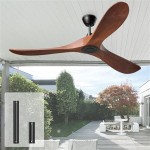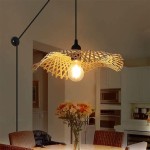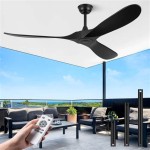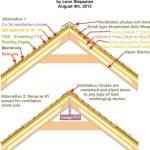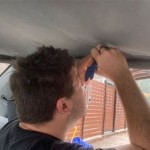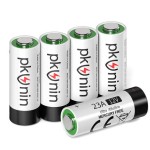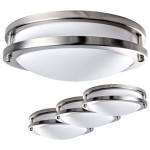How To Replace Ceiling Fan Light Kit: A Comprehensive Guide
Replacing a ceiling fan light kit is a common home improvement task that can update the look of a room, improve lighting efficiency, or repair a malfunctioning fixture. While it may seem daunting, with proper preparation, tools, and adherence to safety guidelines, most homeowners can successfully complete this project. This article provides a detailed, step-by-step guide on how to replace a ceiling fan light kit, covering safety precautions, necessary tools, the removal process, installation procedures, and troubleshooting tips.
Safety First: Disconnecting Power and Gathering Supplies
The most crucial step before commencing any electrical work is to disconnect the power supply to the ceiling fan. This is paramount to preventing electric shock, which can be extremely dangerous or even fatal. Locate the circuit breaker that controls the ceiling fan and switch it to the "OFF" position. As a further precaution, it is advisable to test the fan's light fixture and fan function with a non-contact voltage tester to ensure that the power is indeed off. If the tester indicates the presence of voltage, double-check that you have turned off the correct breaker. If you are unsure or uncomfortable, consult a qualified electrician.
Once the power is safely disconnected, gather all the necessary tools and materials. Having everything at hand will streamline the process and minimize interruptions. Essential tools and materials include:
- Screwdrivers (Phillips head and flathead)
- Wire strippers
- Wire connectors (wire nuts)
- Electrical tape
- Pliers
- Voltage tester (non-contact)
- Ladder or step stool (stable and appropriate height)
- New light kit (compatible with your ceiling fan model)
- Safety glasses
- Work gloves (optional, but recommended)
Before starting, carefully inspect the new light kit for any defects or missing parts. Compare the components with the instructions provided by the manufacturer. Reading the instructions thoroughly before beginning the installation will ensure a smooth and error-free process.
Removing the Old Light Kit
With the power off and tools prepared, the next step involves removing the existing light kit. The exact procedure can vary slightly depending on the design of the old light kit, but the general principles remain the same.
Begin by removing the light bulbs and any glass shades or globes. These are typically held in place by screws, clips, or rotating mechanisms. Set these components aside in a safe location to prevent breakage.
Next, carefully remove the cover or housing that conceals the wiring connections. This cover is often attached with screws. Once the cover is removed, you will have access to the wiring connections. Before disconnecting any wires, take a photograph or draw a diagram of the existing wiring configuration. This will serve as a valuable reference when connecting the new light kit.
Using wire strippers, carefully disconnect the wires. Typically, you will find three wires: a black (hot) wire, a white (neutral) wire, and a green or bare copper (ground) wire. Unscrew the wire connectors (wire nuts) and gently pull the wires apart. If the wires are stiff or corroded, use pliers to gently loosen them. Once the wires are disconnected, the old light kit should be free to be detached from the ceiling fan. Remove any remaining screws or mounting hardware and carefully lower the old light kit from the fan.
Inspect the wiring in the ceiling fan's switch housing. Look for any signs of damage, such as frayed insulation, broken wires, or corrosion. If you find any damage, it is essential to repair it before proceeding. It is also prudent to inspect the ceiling fan's mounting bracket to ensure it is securely attached to the ceiling. If the bracket is loose or damaged, it may need to be tightened or replaced.
Installing the New Light Kit
With the old light kit removed, it is time to install the new one. Carefully follow the manufacturer's instructions provided with the new light kit. These instructions will provide specific guidance on the installation process, which may vary depending on the model of the light kit.
Begin by attaching the mounting bracket that came with the new light kit to the ceiling fan. The bracket is typically attached using screws. Ensure that the bracket is securely fastened to the fan's housing. If the new bracket does not fit properly, you may need to use the existing bracket from the old light kit, provided it is in good condition and compatible with the new light kit.
Next, connect the wiring. Refer to the photograph or diagram you took earlier to ensure you are connecting the wires correctly. Match the wires from the new light kit to the wires in the ceiling fan's switch housing. Typically, you will connect the black wire from the light kit to the black wire from the fan, the white wire to the white wire, and the green or bare copper wire to the green or bare copper wire. Use wire connectors (wire nuts) to securely connect the wires. Twist the wires together tightly with pliers before screwing on the wire nut. After securing the wire nuts, gently tug on each wire to ensure that the connection is secure.
After connecting the wires, carefully tuck them back into the switch housing and secure the light kit's cover or housing. Ensure that the housing is properly aligned and securely attached. This is important not only for aesthetic reasons but also for safety, as a loose housing can vibrate and cause damage over time.
Finally, install the light bulbs and any glass shades or globes. Use the correct wattage bulbs as specified by the light kit manufacturer. Overtightening the shades or globes can cause them to crack or break, so handle them with care. Once the bulbs and shades are installed, double-check that all connections are secure and that everything is properly aligned.
Testing and Troubleshooting
After completing the installation, it is time to test the new light kit. Switch the circuit breaker back to the "ON" position and test the light fixture. If the light turns on, congratulations! You have successfully replaced the ceiling fan light kit.
If the light does not turn on, there are several potential causes:
- Incorrect Wiring: Double-check the wiring connections to ensure they are correct. Refer to your photograph or diagram and the manufacturer's instructions.
- Loose Connections: Ensure that all wire connectors are tightly secured and that the wires are properly connected.
- Faulty Bulb: Try replacing the light bulb with a new one to rule out a faulty bulb.
- Defective Light Kit: If you have checked all the above and the light still does not work, the light kit itself may be defective. Contact the manufacturer or retailer for assistance.
- Circuit Breaker: Verify that the circuit breaker has not tripped during the installation process. If it has, reset the breaker.
- Ceiling Fan Issues: In rare cases, the problem may lie with the ceiling fan itself. If you suspect this is the case, consult a qualified electrician.
If you encounter any difficulties during the installation process or are unsure about any step, it is always best to seek the assistance of a qualified electrician. Working with electricity can be dangerous, and an electrician has the knowledge and experience to ensure that the job is done safely and correctly.
Regularly inspect the ceiling fan and light kit for any signs of damage or wear. Tighten any loose screws or connections, and replace any damaged parts promptly. This will help to ensure the longevity and safe operation of your ceiling fan and light kit.
Replacing a ceiling fan light kit is an attainable project for many homeowners with a basic understanding of electrical work and the right tools. However, prioritizing safety and carefully following the manufacturer's instructions are paramount. When in doubt, seeking professional assistance is always the safest and wisest course of action. A properly installed and maintained ceiling fan light kit can enhance the ambiance and functionality of any room, adding both value and comfort to your home.
Consider the long-term benefits of using energy-efficient LED bulbs in your new light kit. LED bulbs consume significantly less energy than traditional incandescent bulbs, resulting in lower electricity bills and a reduced carbon footprint. They also have a much longer lifespan, reducing the frequency of bulb replacements. This can save you both time and money in the long run.
Remember to dispose of the old light kit responsibly. Contact your local waste management authority for information on proper disposal methods for electronic waste. Some retailers may also offer recycling programs for old light fixtures.

How To Replace A Ceiling Fan Light Kit Smafan Com

Ceiling Fan Light Kit Installation How To
Ceiling Fan Light Fixture Replacement Ifixit Repair Guide

How To Install The Hampton Bay 4 Light Universal Ceiling Fan Kit Youtube

Ceiling Fan Light Repair Home Tutor

How To Easily Repair Or Replace Your Ceiling Fan Chain

Changing Ceiling Fan Light Kit Doityourself Com Community Forums

Wiring Ceiling Fan Light Kit Removing A Wire Cap Doityourself Com Community Forums

How To Install A Hampton Bay Ceiling Fan Light Kit Fans Lighting Patio F Kits With

Swap To Brighter Led Light In Ceiling Fan Doityourself Com Community Forums
Related Posts
